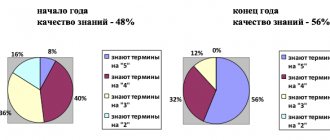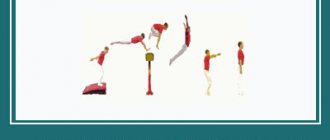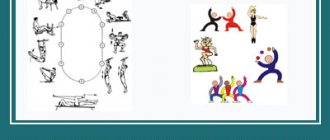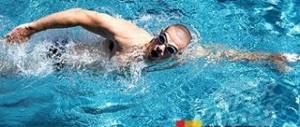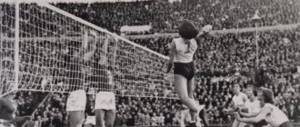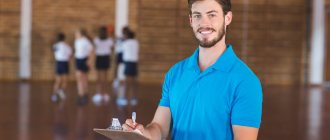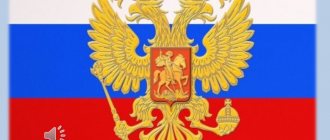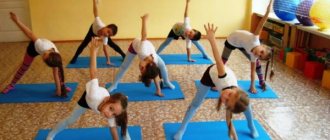Find out the cost of writing such a paper!
Reply within 5 minutes!
Without intermediaries! By adolescence and, especially, adolescence, favorable conditions are created for the development of strength and endurance. To develop strength abilities, exercises of a dynamic nature, local, regional and general effects on the main muscle groups are used mainly. The load amount is generally 10-12 repetitions in 2-3 series with rest intervals between them of 40-60 seconds (heart rate up to 140-170 beats per minute). These are exercises such as: bending, extending the arms while hanging (while hanging while lying down - girls), while lying down, exercises with dumbbells. I vary all these exercises depending on the level of physical fitness of the students. For example, flexion and extension of the arms while lying on an elevated support - for students with poor physical fitness, and flexion and extension of the arms while lying on the floor - for students with a high level of physical fitness.
To develop endurance, I use exercises such as jumping rope and long-distance running.
Exercises for developing physical abilities must be used in the following sequence: at the beginning of the main part of the lesson, exercises for developing speed should be provided, then strength and endurance. Although, depending on the objectives of the lesson, strength exercises can be performed before speed exercises.
All of the above exercises are aimed at the comprehensive development of physical abilities; the time allocated for them in each lesson is 10-15 minutes, and for senior classes 18-20 minutes.
Section "Gymnastics".
When conducting lessons in the “Gymnastics” section, we use group work using the circular training method. In each group, a senior (the most prepared student) is appointed and a set of 4-5 exercises is given. For boys and girls, sets of exercises are formed according to program requirements. In the “Gymnastics” section, sets of exercises are formed, with the help of which preparation is carried out for acrobatic exercises, vaults, hanging and emphasis. This approach allows you to cover a large volume of educational material in a lesson and contributes to the impact on various muscle groups[5].
It is clear that all the means, selected in the most effective way, will cost little if students complete tasks reluctantly and not with full dedication. Therefore, a lot of attention needs to be paid to developing students’ need for independent physical exercise[2].
Section "Sports Games".
During lessons on the “Sports Games” section, it is a mistake to formulate programs for “teaching lesson”, “reinforcement lesson”, “repetition lesson”. During the lessons of this section, the tasks of teaching motor actions, developing physical abilities, and education are implemented - all in a single complex, while training should be “cascading”: some motor actions are just beginning to be developed, others are being improved, and others are being automated.
Since children do not learn the educational material in this section in the same way and already in the first year of classes students with different degrees of preparedness are identified, it is inappropriate to postpone until later the work on eliminating the deficiencies in the technique of those lagging behind.
When setting the general task of the lesson for the whole class, it is advisable to determine tasks for both more prepared and lagging students. Differentiated training can be carried out while working at stations by forming groups according to their preparedness and combining circuit training with specific tasks for each group. This form of classes allows you to increase the density of the lesson and devote more time to each student. Work on the stations is carried out in the form of a circular training, having formed groups taking into account the preparedness of the students, they are offered exercises of varying degrees of complexity.
When working with weak students, in addition to children's inflatable balls or balls from basketball tubes, you can use ordinary balloons, which, as handouts, are best used only when working at stations where no more than 4-6 of them are needed.
In lessons of sports games, it is not recommended to introduce quantitative indicators to assess performance; assessment criteria can be knowledge of the basic elements of movement and the ability to perform them in the whole movement, and forms of knowledge assessment can be questioning and observation.
Section "Ski training".
Ski training lessons are structured using the “circular training” method in an interesting and varied way. All organizational issues are resolved at school or while traveling to the place of classes. It is important to skillfully position stations, taking into account the terrain and specific tasks. “Circuit training” on a training track provides for the availability of a section for a training track, study of the terrain and selection of stations for conducting classes, preliminary analysis and study of stations before the practical lesson.
2. Homework using the circuit training method
Using the circular training method when doing homework is acceptable for children over 10 years of age, i.e. 5th grade students[1].
If there is a developmental delay in a particular student, it is advisable to develop an individual set of exercises. This cannot be done without the help and control of the child’s parents, since it is difficult for him alone without outside help.[1]
- I. p.—arms forward, hands down and then up, arms bent to a position in front of the chest, towards the shoulders, without lowering the elbows. 6-8 times.
- I. p.—sitting cross-legged, hands to shoulders. Circular movements of the shoulders (up-back-down-forward). 8-10 rotations.
- I. p. - stand with closed toes. 1 - hands in front of the chest, elbows at chest level, palms down, fingers touching each other, 2-3 - squeeze your hands forcefully (do not lower your elbows), 4 - turn your hands towards you, 5 - straighten your fingers, 6 - arms down. 6-8 times.
- I. p. - hands in front of the chest. 1 - jerking movements with your arms back, without lowering your shoulders, 2-3 - straightening your arms with your palms up, two jerks back, positioning your hands just above shoulder level, 4 - i. p. 5-6 times.
- I. p.—o. s., hands on the belt. Bend the leg forward, grabbing the handkerchief with your fingers, 2 - and. n. The same, bending the leg back.
- I. p. - lying on your back. Alternately raising the legs, alternately bending the legs; simultaneous bending of the legs, simultaneous raising of the legs 5-10 times.
- I. p. - sitting, arms to the sides. Turn your torso left and right, keeping your arms in the starting position.
Homework, organized according to the training method, helps solve the problem of correcting students’ motor abilities, which are developed taking into account the types of lessons in each quarter, sets of exercises aimed at developing certain “lagging” physical qualities. This makes it possible to vary the direction and volume of physical exercises in physical education lessons, taking into account the identified deficiencies in students’ physical fitness [2].
Pages: 1
Circular training physical education lesson plan (grade 1)
CIRCULAR TRAINING
| Teacher's goals | Develop the ability to independently perform circuit training exercises; develop coordination of movements |
| Lesson type | Solving specific problems |
| Planned educational results | Subject (scope of mastery and level of competency): will learn: to apply the basic movements of basic sports in gaming and competitive activities; analyze execution, find errors and correct them effectively; will have the opportunity to learn: to provide all possible assistance and moral support to peers when completing educational tasks; comply with safety requirements in the gym; Handle equipment with care. Meta-subject (components of cultural competence experience/acquired competence): cognitive – evaluate their achievements, answer questions, relate the studied concepts with examples; communicative - master the dialogical form of speech, the ability to engage in verbal communication; Regulatory - master the ability to understand the educational task of the lesson and strive to fulfill it. Personal: acceptance and mastery of the student’s social role; development of motives for educational activities and the formation of personal meaning of learning; development of cooperation skills with adults and peers in different social situations |
| Methods and forms of training | Partially search; individual, frontal |
| Educational Resources | Stopwatch, hoops (according to the number of students at the station), jump ropes (according to the number of students at the station), 3 volleyballs, 3 medicine balls |
ORGANIZATIONAL STRUCTURE OF THE LESSON
| Lesson steps | Educational and developmental components, tasks and exercises | Teacher activities | Student activities | Forms co-actions | Universal learning activities | Types of control |
| 1 | 2 | 3 | 4 | 5 | 6 | 7 |
| I. Organizational moment | Emotional, psychological and motivational preparation of students to master the material being studied | Forms a line. Checks students' readiness for the lesson, voices the topic and purpose of the lesson; creates an emotional mood for learning new material | Perform construction. Listen and discuss the topic of the lesson | Frontal | Personal: understand the meaning of knowledge for a person and accept it; have a desire to learn; respond positively about school; correctly identify themselves with the position of the student | Oral survey |
| II. Updating knowledge | Execute drill organizing commands. Running in circles. Exercises to restore breathing. Warm-up in motion (see Appendix 1) | Gives the commands: “Get in line!”, “Attention!”, “Right!”, “March to the left in a detour!”, “Running march!”. Monitors the execution of the task. Conducts breathing exercises. Formulates the task, provides motivation for completion, exercises control | Execute commands (30–40 s). Complete the task. Do the exercises. Doing exercises | Frontal. Frontal | Personal: show discipline, hard work and perseverance in achieving goals; know how to manage emotions when communicating with peers and adults. Regulatory: accept and maintain the learning task when performing exercises; carry out final and step-by-step control; adequately perceive the teacher's assessment. Communicative: use speech to regulate their actions; interact with peers in joint activities; control the partner's actions | Carrying out actions according to instructions |
| III. Learning new material | Circuit training (see Appendix 2). | Reminds me of the rules for performing circuit training. Announces to students | Perform circuit training tasks. | Frontal. | Cognitive: general educational – independently identify and formulate goals and methods for achieving them | Implementation |
End of table.
| 1 | 2 | 3 | 4 | 5 | 6 | 7 |
| Outdoor game “Calling numbers” (see Appendix 3) | about free exercise at the station they like, but warns: as soon as they hear the signal (whistle, clap), they need to collect their equipment. Explains the rules and plays the game | Participate in the game | Frontal | implementation; logical – search for the necessary information. Regulatory: carry out step-by-step control of their actions, focusing on the teacher’s demonstration of movements. Communicative: use speech to regulate their actions; interact with peers in the game; control the partner's action | self-control according to the model. Carrying out actions according to instructions | |
| IV. Primary comprehension and consolidation | Exercises to develop coordination and attention | Formulates the task: 1) throw a tennis ball at the wall with one hand, catch it with the other; 2) throw the ball with your back to the wall, catch it with your face turned; 3) throw the ball held by the toes while jumping | Complete the task | Frontal | Regulatory: act taking into account the guidelines identified by the teacher; adequately perceive the teacher's assessment | Carrying out actions according to instructions |
| V. Lesson summary. Reflection | Summarize the information received in the lesson | Conducts a conversation on the following questions: – At which station do you perform the circuit training exercises best? – How else can you develop speed qualities? | Answer to questions. Determine their emotional state in class | Frontal | Personal: understand the meaning of knowledge for a person and accept it. Regulatory: predict the results of the level of mastery of the material being studied | Evaluating students for their work in class |
Annex 1
Warm up on the move
Exercises are performed for 10–20 seconds.
1. Arms to the sides, simultaneously and alternately, circular movements of the forearms in and out.
2. Arms to the sides, turning the arms with palms up, palms down.
3. For each step, raise your right shoulder; raise your left shoulder; lower your right shoulder; lower your left shoulder.
4. Circular movements of the shoulders forward and backward.
5. Circular movements of the arms simultaneously and alternately back and forth.
6. For each step, lift your leg, bent at the knee, grab it with your hands and pull it to your chest (without bending), release it. Perform with the right and left legs in turn.
7. For each step, lunge forward.
8. Movement in a backward position, lunge backwards for each step.
9. Jump from the right and left legs in turn.
Appendix 2
Circuit training
There are 4 stations: 3–4 minutes are given to complete each one.
1st station – passing the ball in pairs. Passing and catching in three arbitrary ways. At the teacher's command, the method of transmission changes.
2nd station – jumping rope. Try jumping in different ways (at least three).
3rd station – hoop rotation. On the left hand, on the right, on the belt.
4th station - medicine ball throws in different ways: with both hands from below, from the chest, from behind the head. (The teacher is here, helping the children complete the task safely, while simultaneously monitoring the change of tasks after 1 minute and the change of stations after 3-4 minutes.)
